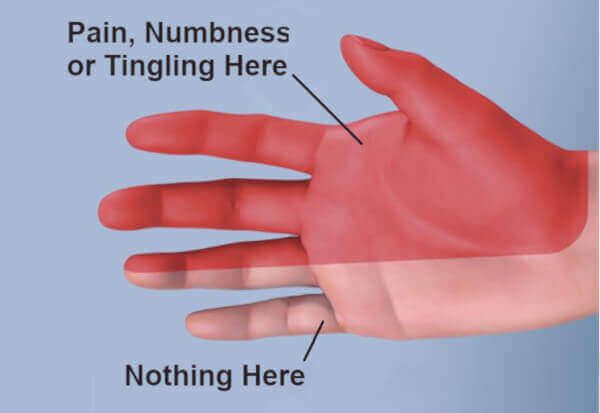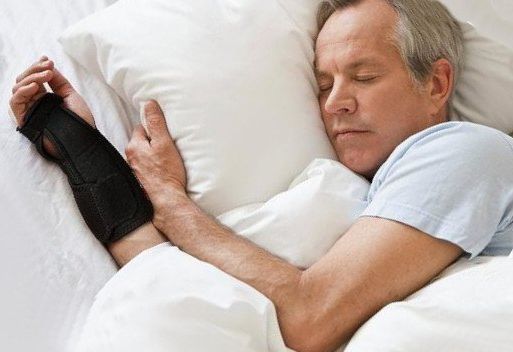For the Phalen test, bend your affected hand 90 degrees. Hold it for 60 seconds. (You can push against a a wall to hold it.) It's positive for carpal tunnel syndrome if you feel symptoms in your fingers like numbness, tingling or pain.
How to Avoid a Carpal Tunnel Misdiagnosis
From Dr. Z - Carpal tunnel syndrome specialist
Did You Get a Carpal Tunnel Misdiagnosis?
It's hard to imagine, but the chances that your doctor will give you a carpal tunnel misdiagnosis are high. (That means telling you that you have carpal tunnel, when you actually don't.) According to a report by the National Institutes of Health (NIH), the rate of diagnosing your symptoms as carpal tunnel (when it's something else ) is over 83%.
The common "next-step" is for doctors to advise patients with severe symptoms to have carpal tunnel surgery. But why have this surgery when you don't have carpal tunnel syndrome?
You might think,
“My doctor doesn’t misdiagnose!” And maybe you're one of the lucky ones where this is true. But the high rate of carpal tunnel misdiagnoses forced the NIH in 2010 to issue a warning to doctors. The warning asks doctors to double check their findings due to the huge increase in (unnecessary) surgeries as a result of a carpal tunnel misdiagnosis.
- Think you have carpal tunnel? Complimentary self-test
- Already have carpal tunnel? This Quiz shows you its severity
Along with the American Academy of Orthopedic Surgeons, the NIH told doctors the following: "Advise your patients to use all non-surgical options first to treat their hand problems before considering surgery."
Carpal tunnel release surgery is a huge commitment of time, money, and pain. Yet, it often fails - largely because the patient never had carpal tunnel to start with!
This NIH announcement was an important milestone for all doctors and patients.
The problem with a carpal tunnel misdiagnosis
If you have finger, hand, or wrist pain or numbness, your first step might be to search the internet for what’s causing the discomfort. You soon conclude your symptoms look like carpal tunnel syndrome. And it’s a likely probability given how many people actually have this disorder.
However, you might instead have wrist flexor tendinitis - a condition that's 10 times more prevalent.
A surprising finding by the NIH is that your own doctor may not recognize the difference between these two conditions. It’s a big problem because:
- If the doctor can misdiagnose carpal tunnel as tendonitis, then the carpal tunnel syndrome goes untreated and worsens.
- If the doctor misdiagnoses tendonitis as carpal tunnel syndrome, then surgery is usually recommended. But the surgery will fail because there is no carpal tunnel to begin with.
Therefore, a carpal tunnel misdiagnosis by your doctor can result in needless pain, suffering, lost job time, and even unnecessary surgery.
Why a carpal tunnel misdiagnosis is easy to make
Carpal tunnel syndrome and wrist flexor tendinitis symptoms are very similar. In fact, carpal tunnel syndrome essentially IS wrist flexor tendinitis that’s focused inside the wrist joint.
Both conditions can be painful. Also, both cause numbness, tingling (or "pins & needles"), burning, and loss of pinch and grip strength. However, that’s where the similarities end.
Unlike carpal tunnel syndrome, wrist flexor tendonitis usually does not cause
shooting electric shocks. It also rarely results in clumsiness, weakness, and loss of dexterity.
Here's how you can tell the difference
You can tell the difference between carpal tunnel syndrome and wrist flexor tendonitis relatively easily. This way you can double-check your doctor to insure he/she didn't give you a carpal tunnel misdiagnosis.
For testing carpal tunnel syndrome, use the Phalen, Tinel, and Durkan tests. These are the exact same tests an experienced doctor uses in the office. The illustration above shows how they're performed.
Tests for carpal tunnel syndrome
Phalen test
Tinel test
Durkan test
Tests for wrist flexor tendonitis
Percussion test
Why are symptoms so similar?
Carpal tunnel syndrome and wrist tendinitis start with one basic problem: inflammation of wrist and forearm tendons. However, they are different disorders because of what causes them to be painful.
Wrist tendonitis: In wrist tendinitis the tendons or their sheaths (coverings) are inflamed. They swell with fluid and irritate tiny nerve endings around them. Therefore, it's overall inflammation and swelling that causes the symptoms of tendonitis.
Carpal tunnel syndrome: In carpal tunnel syndrome, the tendons also swell with fluid. However, the swelling happens ONLY deep inside the wrist joint. The swelling exerts pressure directly on the adjacent median nerve, and crushes it. Therefore, it’s that direct nerve compression that causes the symptoms of carpal tunnel syndrome.
Now you see why even doctors can be confused about which condition you have. As a result, your doctor can easily make a carpal tunnel misdiagnosis and call it wrist tendinitis, or vice versa.
Be smart and know the difference
Okay, so the underlying pathology of these two conditions is similar. And their symptoms are nearly identical. Therefore, it’s easy to see how one condition can be confused with another. But doctors are supposed to know the difference, right?
Sadly, many don’t.
A knowledgeable and experienced carpal tunnel doctor uses the simple tests above to differentiate between carpal tunnel and wrist flexor tendinitis. These are well-documented methods to differentiate one from the other, and have been used successfully for decades.
In fact, the National Institutes of Health reports that the above tests are more reliable in determining carpal tunnel than expensive, electrodiagnostic tests like EMG. Best of all, you can perform these exact same tests on yourself.
What can I do for my condition?
Now for some happy news: if your self tests indicate you have carpal tunnel syndrome or wrist tendinitis, then you can begin treating immediately. The National Institutes of Health and the American Academy of Orthopedic Surgeons suggest taking 4 distinct and simultaneous actions.
These actions will most likely get rid of symptoms and avoid long term suffering. The actions are Night bracing, Rest, Exercise, and Massage.
Night bracing
Rest
Night bracing
Night bracing
Conclusion
The chances of getting a carpal tunnel misdiagnosis by your doctor is high. Often, wrist flexor tendinitis is wrongly diagnosed as carpal tunnel syndrome. Conversely, carpal tunnel is also often wrongly diagnosed as wrist tendinitis. But you can take steps to relieve the symptoms of either condition, no matter what the diagnosis is. Moreover, it’s important to do so now, before symptoms worsen.















